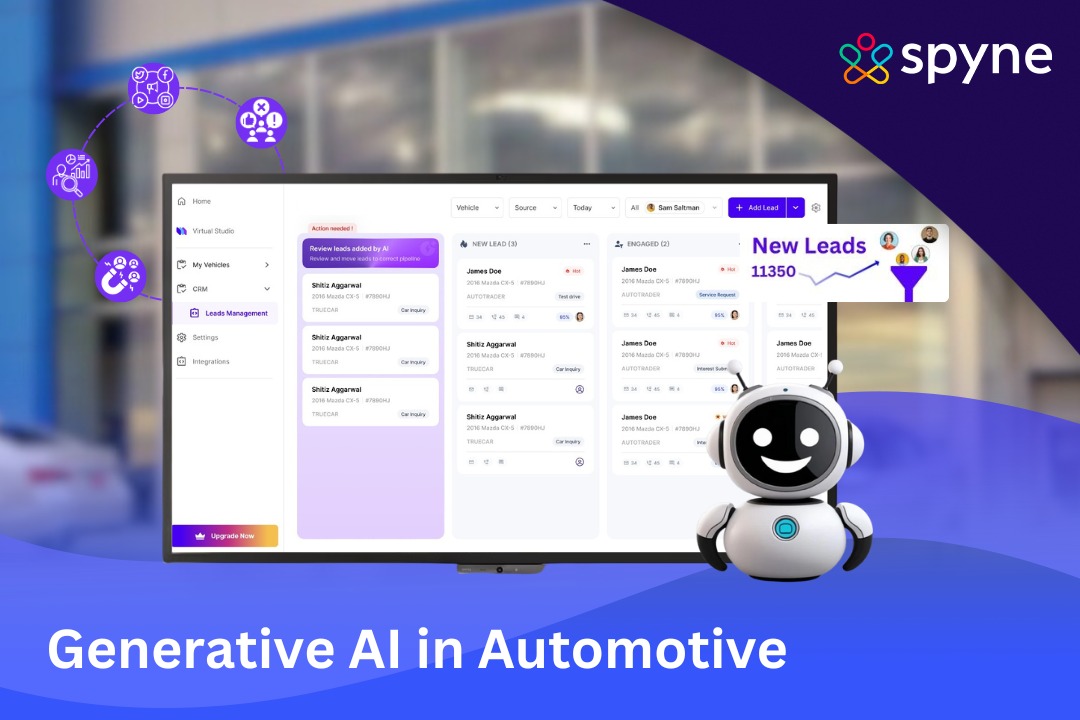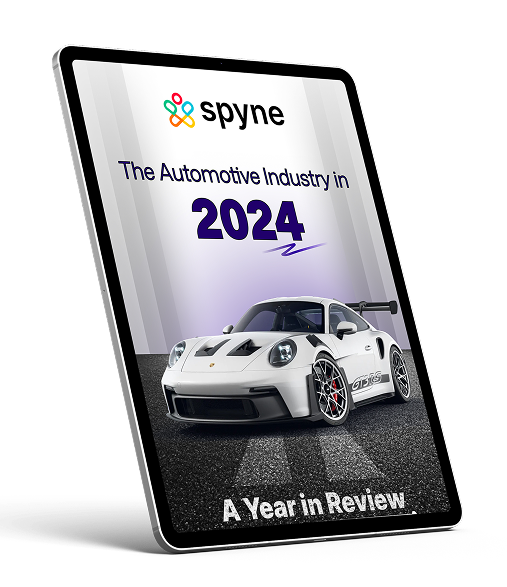Generative AI in automotive industry is transforming the way car dealerships engage with customers, from AI-powered chatbots responding to queries in seconds to callbots that do not let any leads slip away. All from lead management to customized shopping experiences, this latest technology wave automates everything, transforming the entire customer journey into faster, simpler, and smarter. Here, we discuss what generative AI is, its most popular applications in the automotive industry, the leading companies, and key trends to observe in 2025.
What is Generative AI in Automotive?
Generative AI in automotive industry involves using intelligent systems like callbots and chatbots that are capable of communicating, understanding, and aiding customers as a human would. They are trained to perform everything from discussing car models to booking test drives or service appointments. They are not just going through scripts; they learn from customer actions and react normally.
For car dealerships, this means more leads, quicker follow-ups, and a more satisfied customer. Whether helping choose the ideal car or reminding them of servicing, automotive generative AI makes the whole customer journey faster, easier, and more tailored.
12 Game-Changing Use Cases of Generative AI in Automotive Industry
Generative AI in automotive industry is revolutionizing how car dealerships interact with customers prior to, during, and after the sale. From smart chatbots that assist buyers to voice-enabled callbots that support service, and automotive CRM tools that streamline engagement, here are the best use cases transforming the sector.
1. AI Chatbots for Real-Time Vehicle Recommendations
AI chatbots assist customers in finding their ideal vehicle by considering budget, lifestyle, and interests. They give real-time responses on models, pricing, and options, making the purchase process easy.
2. Voice-Based Callbots That Never Miss a Lead
Callbots using automotive generative AI respond to dealership calls 24/7, take down lead information, and distribute it to the appropriate sales representatives. This way, every lead is addressed, even during off-hours or busy hours.
3. Personalized Upselling and Cross-Selling
Based on prior conversations or call history, AI lead generation for car dealerships recommends relevant upgrades such as premium trims or add-on services, driving revenue through customized recommendations.
4. Real-Time Lead Qualification through AI Dialogues
Chatbots and callbots can pose pre-designed qualifying questions to focus on high-intent buyers first. This enables sales teams to concentrate on leads that are most likely to convert.
5. Automated Test Drive and Service Booking
Customers can book test drives or service appointments straight with a bot, without holding or queuing. Bots instantly verify availability and bookings.
6. Multilingual Customer Support at Scale
Generative AI for automotive is able to change language instantly, enabling dealerships to connect with more customers using individualized, native-language support.
7. AI Follow-Ups That Increase Showroom Visits
Following initial interest, bots send follow-up messages, deals, or reminders to encourage customers to visit the showroom or make a booking.
8. FAQ Handling to Offload Support
From “What’s the on-road price?” to “Is the model available?”, AI bots answer repetitive questions in real-time, saving staff and reducing response time.
9. Smart Routing to Sales, Finance, or Service
Callbots hear what the caller wants: sales, financing, service, and immediately transfer the call to the appropriate team. No more being bounced around.
10. Post-Purchase Customer Satisfaction Bots
After a purchase, AI bots follow up with buyers, solicit feedback, and offer advice on the use of vehicle features. This generates loyalty and enhances customer satisfaction.
11. AI for No-Show Reduction and Appointment Reminders
Generative AI for automotive callbots and chatbots delivers timely reminders in advance of booked appointments or test rides, minimizing no-shows and optimizing operational efficiency.
12. Tying Bots with CRM for Smarter Engagement
Each call or chat is recorded and synchronized with the car dealership CRM, providing teams complete visibility into customer history, allowing smarter, more contextual conversations in the future.
Advantages of Generative AI in Automotive Industry
Generative AI in automotive industry is revolutionizing the automobile business by offering many advantages affecting businesses as well as consumers. This technology is influencing marketing strategies for automobiles and assisting automobile dealerships in remaining competitive in a fast-changing automobile market.
1. Top 4 Advantages of Generative AI For Automobile Dealerships
- Increased Efficiency and Cost Control- Generative AI automotive industry saves manufacturers and dealers money by minimizing waste and accelerating work. Chatbots and callbots process customer calls and messages automatically, saving time and reducing expenditures.
- Adaptive Inventory and Supply Chain Management- AI monitors inventory and makes rapid adjustments when demand shifts. Chatbots respond to customer inquiries about vehicles instantly, enabling dealers to manage their inventory more effectively and keep customers satisfied.
- Increased Customization for Customers- AI in automotive industry enables dealers to provide customized car choices and services. Callbots converse with buyers according to their liking, ensuring the purchasing process becomes more personal and enjoyable.
- Faster Product Development and more Intelligent Sales- AI accelerates the development of new cars and enhances advertising. Chatbots converse with customers, assist in locating what they are looking for, and schedule appointments, allowing dealerships to sell cars quickly and more easily.
2. Top 4 Generative AI Benefits For Car Dealerships Consumers
- Custom Car Settings for a Comfortable Ride- AI tweaks car settings such as seats and temperature to match every driver’s preference. Customization makes the ride more comfortable and finds application in car dealership advertising techniques.
- Enhanced Safety and Intelligent Navigation- AI in automotive industry monitors traffic and road conditions to inform drivers about safer, quicker routes. This intelligent navigation is a favorite among used car marketing campaigns to appeal to consumers.
- Preventive Vehicle Maintenance- Generative AI automotive industry informs drivers when their vehicle requires servicing or repair. This prevents breakdowns and keeps vehicles in top condition, a feature dealers prefer to highlight in auto marketing campaigns.
- Tailored Shopping and Car Customization- Automotive artificial intelligence recommends vehicles and accessories according to what customers are fond of. It simplifies shopping and makes it enjoyable, and dealerships use this to market and enhance customer experience.
Top 6 Innovators Using Generative AI in Automotive Industry
Generative AI in automotive industry is revolutionizing the automotive sector, enabling leading companies to innovate, improve customer experience, and grow marketing efforts.
1. Mercedes-Benz
Mercedes-Benz implements ChatGPT in 900,000+ vehicles to allow natural language control of vehicle functions. This technology increases driver convenience by offering personalized settings and enhanced user interaction. These innovations complement automotive marketing efforts, emphasizing intelligent, technologically advanced features appealing to today’s consumer looking for convenience and customizability.
2. Toyota
Toyota uses generative AI automotive to transform text concepts into electric car designs in a short time. The AI in the automobile industry provides aerodynamic performance and comfort in the cabin while accelerating product development. It supplements car dealership marketing strategies by enabling Toyota to rapidly provide innovative electric cars that address customers’ needs and market trends.
3. CarMax
CarMax utilizes AI for the automated writing of in-depth descriptions for thousands of vehicles sold online. This enhances SEO and customer experience by making listings more appealing and accessible. These AI-enabled upgrades are crucial for used car marketing plans to drive web traffic and enhance sales conversion rates.
4. BMW
BMW uses cloud-enabled generative AI to create next-generation driver-assistance systems for safer, smarter cars. Automotive artificial intelligence facilitates quicker software updates and instant analysis of data, enhancing ride quality and safety. These initiatives support automaker marketing efforts for advanced technology and improved vehicle security.
5. CarGurus
CarGurus combines ChatGPT-based AI to provide customized car search support, enabling buyers to find suitable vehicles at a fast pace. This conversational AI enhances user interaction and streamlines the process of buying a vehicle. Features like this are important in auto dealer marketing initiatives aimed at customer experience improvement and online conversion boost.
6. Tesla
Tesla employs generative AI to enhance autonomous driving and vehicle design, battery life, and safety. Tesla’s fleet provides real-time data, which enables continuous enhancements by means of over-the-air updates. These developments complement automotive marketing efforts focused on sustainability, state-of-the-art technology, and better vehicle performance.
Top 6 Generative AI in Automotive Industry Trends in 2025
Generative AI in automotive industry is transforming how dealerships connect with buyers and how customers experience car shopping. From advanced chatbots to real-time personalization, here are the top trends redefining automotive engagement in 2025.
1. Conversational AI as the First Point of Contact
Dealerships’ conversational AI is replacing static forms and long wait times with AI-powered chatbots and callbots. Tools like Spyne’s provide 24/7 assistance from lead capture to appointment booking, making customer interactions faster and smarter.
2. Hyper-Personalized Customer Experiences
The AI for car dealerships now tailors every touchpoint based on browsing behavior, preferences, and past conversations. Whether it’s recommending the right vehicle or sending the perfect follow-up message, personalization at scale is becoming the new standard.
3. AI Voice for Smarter Call Handling
Automotive AI chatbot now handles voice conversations just like a human, taking bookings, answering questions, and routing calls to the right team, even after hours. Spyne’s voice solutions enable dealerships to never miss a lead again.
4. Real-Time Lead Qualification and Prioritization
AI for car sales leads listens, learns, and qualifies leads on the fly. It routes high-intent buyers directly to sales teams, helping dealers close deals faster and reduce response times.
5. Smarter In-Car Experiences
AI is being used inside vehicles to personalize music, climate control, and navigation based on the driver’s preferences. These innovations enhance comfort and align with the expectations of today’s tech-savvy buyers.
6. Personalized Car Shopping Journeys
From online chat assistance to AI-curated recommendations, buying a car has never been easier or more intuitive. Dealerships leveraging generative AI are creating seamless, enjoyable shopping journeys that boost conversions.
How Spyne’s Generative AI in Automotive Industry Helps Car Dealerships
Spyne retail AI offers tools such as generative AI in automotive industry, empowering car dealerships with AI-driven tools that streamline lead handling, customer support, and sales engagement all in real time. From instant conversations to automated follow-ups, here’s how Spyne’s generative AI transforms dealership operations:
1. 24/7 Chatbot and Callbot Support
Spyne’s automotive chatbots handle customer interactions around the clock, answering questions, capturing lead info, and booking appointments even outside working hours. This ensures no missed opportunities and provides a frictionless experience for buyers browsing at any time.
2. Automated Lead Qualification and Routing
Our bots ask pre-set qualifying questions during calls or chats to assess buyer intent. Hot leads are auto-routed to the right sales rep or department, helping teams prioritize efforts and close more deals efficiently.
3. Instant Appointment Scheduling
Whether it’s a test drive or a service visit, Spyne automotive chat allows customers to instantly book slots based on real-time availability. No wait times, no hold music, just smooth scheduling integrated with your calendar system.
4. Personalized Conversations that Convert
Spyne’s bots remember previous chats, preferences, and behaviors. This allows them to greet customers by name, suggest the right models, and offer add-ons or service upgrades, making every conversation feel tailored and sales-focused.
5. CRM Integration for Smarter Engagement
Every call or chat is logged and synced with your automotive CRM. This gives your sales and support teams full context, enabling smarter follow-ups, better targeting, and continuity across customer touchpoints.
6. Multilingual and Voice-Enabled Capabilities
Spyne’s bots can speak and understand multiple languages and accents, making them ideal for diverse markets. Whether through voice or text, they deliver natural conversations that feel human and inclusive.
7. AI-Powered Follow-Ups and Nurturing
After a lead interacts with your dealership, Spyne’s automated lead follow-up system for car dealerships continues the conversation with automated messages, appointment reminders, or offers. These follow-ups keep customers engaged and boost your chances of converting leads into showroom visits.
8. Real-Time Analytics and Performance Insights
Spyne tracks every interaction from lead source to bot performance. Dealerships get actionable insights on response times, conversion rates, and customer behavior, helping them optimize their sales and marketing strategies continuously.
Conclusion
Generative AI in automotive is transforming how dealerships operate, from smarter customer conversations to higher lead conversions. Spyne’s AI-powered solutions like chatbots, callbots, and CRM-integrated tools help you engage customers faster, follow up smarter, and sell more efficiently. Whether you want to reduce response times or personalize the car-buying journey, Spyne equips your dealership with everything you need to stay ahead. Ready to elevate your dealership with AI? Book a Free Demo Today with Spyne.
















